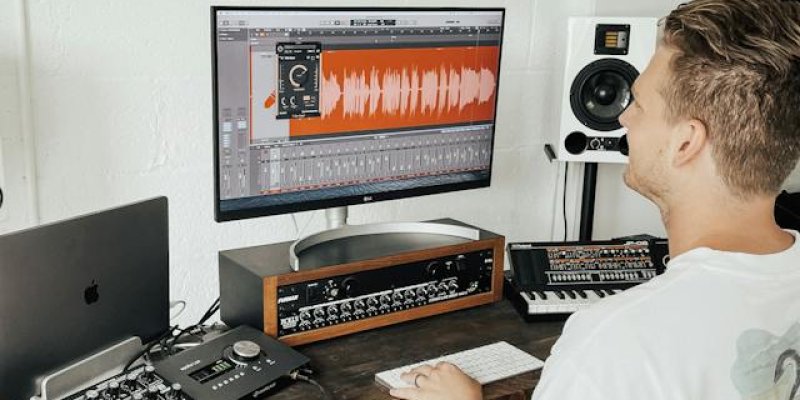
A lot of newbies and non-musicians like to think that gain and volume control are basically the same thing, but I want to tell you that they are definitely not!
Whether you're an avid audiophile, a budding musician, or an aspiring sound engineer, knowing the difference between gain and volume will not only enhance your listening experience but also empower you to create exceptional songs with high quality.
Gain refers to the amplification of an audio signal. It determines how much the input signal is boosted before reaching the output. In simpler terms, gain controls the strength or power of the signal.
Musicians and audio engineers use gain to adjust the sensitivity of microphones, instruments, and other audio sources, ensuring that the signal is strong enough for further processing without introducing unwanted noise.
Related Post: What Does An Audio Interface Do? In Simple Terms
In stark contrast to gain, volume governs the audible output's intensity, shaping the listener's perception of loudness. When you adjust the volume, you're essentially managing how loud or soft the audio sounds to your ears.
Whether you're enjoying music at home, attending a live concert, or mastering a recording, volume control provides the means to create an immersive auditory experience tailored to individual preferences and environmental considerations.
In essence, gain influences the input signal's strength and quality, while volume manages how loud or soft the audio sounds to your ears.
Gain is like the source control, shaping the foundation of the audio, whereas volume is the output control, determining how loud the audio is in the environment.
Understanding this distinction helps in making precise adjustments for the best audio experience.
Related Post: Music Dynamics - What They Are And How They Shape A Performance
Adjusting volume instead of gain is typically the preferred approach in the studio or recording environment when you want to maintain the integrity of the original signal. Here are a few scenarios where adjusting volume is more appropriate:
Mixing and Balancing
During the mixing process, adjusting the volume levels of individual tracks allows you to create a balanced and cohesive sound.
It lets you blend various elements of the mix, making sure that each instrument or vocal sits well within the overall sound without altering the recorded qualities of the tracks.
When recording, performers often wear headphones to hear themselves and the backing tracks.
Instead of altering the gain, the headphone volume control is used to adjust how loud or soft the mix is in the headphones. This ensures the performers can hear themselves clearly without affecting the recording levels.
Room Acoustics
In a recording studio, the room acoustics can vary. Adjusting the monitor volume helps compensate for the room's characteristics, allowing engineers to hear the mix accurately without altering the original signals' gain settings.
Adjusting gain becomes crucial in the studio or recording process when you need to modify the original signal's strength and quality. Here are situations where adjusting gain is more appropriate:
Input Signal Strength
If the incoming audio signal from a microphone or instrument is too weak, increasing the gain at the preamp stage ensures a strong and clean signal for recording. Proper gain setting is key for capturing subtle sounds without introducing unwanted noise.
Preventing Clipping
When the input signal is too strong and risks clipping (distorting), reducing the gain prevents distortion and ensures a clean recording.
Clipping occurs when the signal exceeds the maximum level that the recording system can handle, resulting in a harsh, distorted sound.
Microphone Techniques
Adjusting the gain is crucial when using microphone techniques such as close miking or distant miking.
Different miking techniques capture varying amounts of sound energy, and adjusting the gain helps optimize the microphone's sensitivity to match the desired sound capture.
Related Post: Is There A Such Thing As An Autotune Microphone?
Adjusting the volume may seem doable, but adjusting the gain throughout a recording or performance can be very time-consuming and complicated. This is where the process of gains staging comes into play.
Gain staging ensures that your audio signal is at the perfect level—not too soft that it gets lost in the background noise, and not too loud that it distorts or sounds bad.
It's like finding the "Goldilocks zone," where the signal is just right—strong enough to overcome any background noise but not so strong that it causes problems in the equipment it passes through.
For example, electronic hi-hats might seem quiet, but if they're too strong, they can cause distortion in the equipment they're sent to.
Gain staging helps you find the ideal strength for your audio signal at each stage of your recording or processing, giving you the best possible sound quality without any unwanted noise or distortion.
It's all about finding that perfect balance so your audio travels smoothly from one processing step to the next.
Related Post: What Is Compression When It Comes To Music? In Simple Terms

As a session singer, writer, and producer that has worked with over 300 clients to provide high-quality jingles, singles, and features, Yona spends her time creating and marketing new music and helpful resources for creators. Check out Yona’s latest releases on her Spotify, her Youtube and share if you like it!
If you are in need of singer, songwriter or song producer services, see what Yona Marie can offer you on her services page.